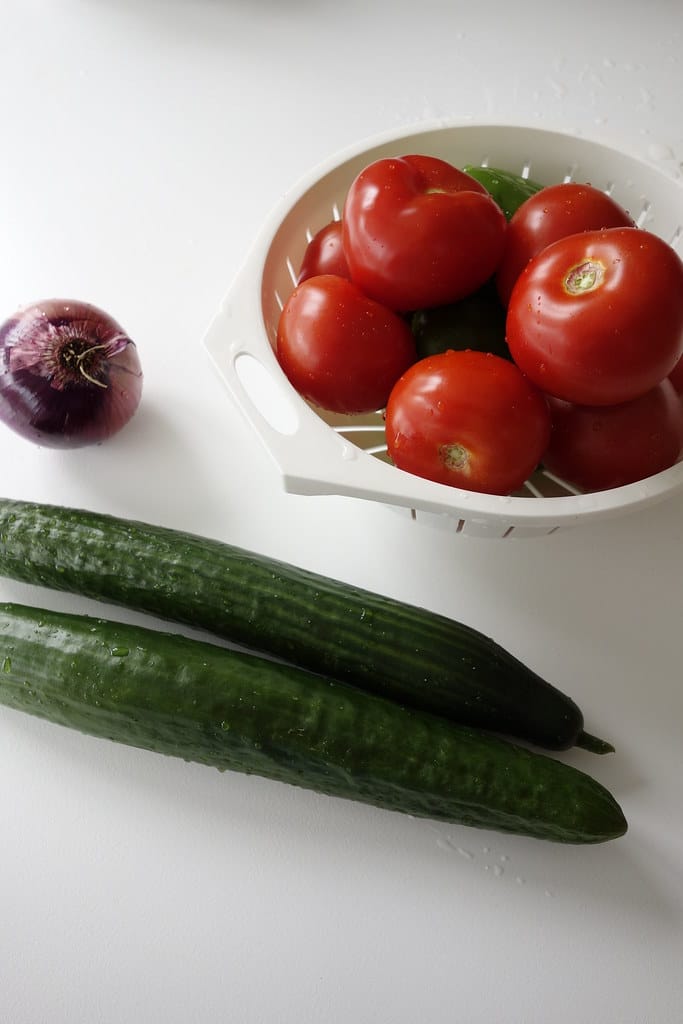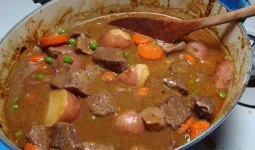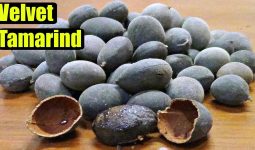Many people may not know that there are several different types of Cucumber. Cucumber plants are warm-weather plants that may thrive in hotter climates.
They are ready to harvest in around 60 days, making them suitable for growing even in areas where hot weather only occurs for a few months a year.
These plants are simple to grow and provide a lot of enjoyment. In this article, we will discuss the different cucumber varieties that are available.
1. English Cucumber

This variety’s cucumbers are long and thin, with narrower ends. They usually range in size from 10 to 15 inches.
The cucumber’s dark green skin is smooth or slightly ridged, and the skin is so thin that it does not need to be peeled before eating.
These cucumbers are regarded as the ‘common’ cucumber in most European countries. However, they are less prevalent in North America.
They have a little sweeter flavor than regular garden cucumbers, and the flesh is a very pale green, almost white, and juicy.
English cucumbers have no seeds and are frequently called “seedless cucumbers.” These cucumbers are typically sold wrapped in plastic to enhance their shelf life.
Furthermore, they’re best served raw in salads and sandwiches but also delicious in cocktails like martinis and G&Ts.
2. Green Finger Persian Cucumber
This species of Persian cucumber is perfect for snacking because it matures to a bit size of between 3 and 5 inches, which explains why it’s called ‘green fingers.’
These cucumbers are easy to cultivate from seed. They germinate in about seven days and harvest in about sixty days.
In milder climates, these plants can be planted in early April and harvested by late June. They will continue to produce cucumbers throughout the summer, providing a long harvest season to enjoy these crunchy fruits.
The plants can be grown outside in May in colder climates, with the earliest possible harvest date being late July. Furthermore, This plant has a fast-growing habit, producing vines up to 5 feet tall with shallow roots.
3. Munchers Cucumber
When fully ripe, these cucumbers are 8 to 10 inches long and 2 to 3 inches wide, making them ideal for slicing. They can, however, be used as pickling cucumbers when young and much smaller.
These cucumber seedlings will germinate in three to ten days and be ready to harvest in 58 to 65 days. They’re seedless and burpless, which means they contain very little or no cucurbitacin, the gas-producing component found in cucumbers.
This is one of the different types of cucumbers. Its skin is fragile and quickly eaten, and the fruit is crunchy and bitter-free.
4. Ashley Cucumber
These heirloom cucumbers were created in 1956 in Charleston, South Carolina. They are prevalent for growing in hot, humid settings because they are resistant to downy mildew, which damages many other cucumber varieties in these conditions.
When ready to harvest, Ashley cucumbers mature in about 65 days and measure between 6 and 8 inches long.
However, they are dark green in color and taper at the end where they connect the plant’s stem. They have a rough texture, with some bumps on the surface.
Furthermore, these cucumber plants are noted for their high yields and are popular for home gardeners and farmers’ markets in the southern United States.
5. Diva Cucumber
When mature, these cucumber plants yield snack-sized cucumbers that measure roughly 5 inches long. They’re great in kids’ lunchboxes, on picnics, or as a snack right off the plant.
They have a crisp texture and a light flavor, making them ideal for serving as crudites on a hot summer day. This plant is recognized for providing a large output of cucumbers and may be grown outside and in a glasshouse.
These cucumbers are one of the different types of cucumbers that contain seedless flesh and smooth, glossy, medium to deep green skin.
Also, this is a highly popular cucumber to raise because of the delicious and gorgeous cucumbers it produces. It’s a multi-award-winning cultivar.
6. Sweet Success Cucumber
This cucumber variety will be ready to harvest in 54 days. It produces huge cucumbers with a length of at least 14 inches.
This is one of the different seedless and burpless cucumber types, and they have a sweet, non-bitter flavor.
Their skin is dark and smooth, thin enough to eat the fruit without peeling. They’re perfect for salads and other savory cold foods.
Moreover, this cucumber plant has won numerous awards for its outstanding performance. It is resistant to many diseases that often attack cucumber plants, such as leaf spot, scab, and cucumber mosaic virus.
7. Straight Eight Cucumber
This cucumber plant produces straight cucumbers eight inches long, just as its name says. The fruits have a spherical form and smooth, dark green skin at either end.
Also, this is a heritage cucumber cultivar that has been popular among home gardeners for decades due to its consistent yield and tasty cucumbers.
It’s a simple plant to grow, and it’s frequently picked as the cucumber variety to grow with kids to pique their interest in gardening.
Unlike other cucumbers, which are either pickled or sliced, this multi-purpose cucumber may be eaten raw in salads or pickled, though it is most usually used for slicing.
Furthermore, This plant has a trailing habit, with tendrils reaching 6 to 8 feet. When grown on a trellis, it produces the best results. This is one of the different types of cucumber.
8. Bush Champion
Bush Champion produces eight- to eleven-inch fruits on compact vines. In just 60 days, this hybrid bush variety produces straight, crisp, vivid green cucumbers.
This Burpee unique is resistant to mosaic virus and ideal for container or raised bed gardening.
9. Alibi Cucumber
Although the fruits are versatile and may be eaten raw, this is considered one of the greatest types of pickling cucumbers you can cultivate.
These cucumbers will be roughly 4 inches long and half an inch wide when fully mature. They have medium green, smooth skin.
Furthermore, these cucumber plants are noted for consistently delivering significant fruit harvests. The vines are disease-resistant, and the fruits are uniform in size and appearance.
Between days 45 and 55, cucumbers will be ready to harvest. These small vines will work well for anyone who wants to cultivate cucumbers in a small space. This is one of the different types of Cucumber.
10. Double Yield Cucumber
Because of the very large output of fruits, this cucumber plant species has been widespread since the 1920s.
The name ‘double yield’ suggests that this plant produces an abundance of cucumbers. Also, the fruits are around 4 to 6 inches long and have rounded ends.
Furthermore, the skin is medium green to yellow-green with occasional black spines. After 52 days of seeding, these cucumbers are ready to harvest.
They’re fantastic for pickling, but they’re also deliciously eaten right from the vine. This is one of the different types of cucumber.
11. Liberty Cucumber
In 1978, this cucumber plant won the All-American Selection award; nevertheless, it has fallen out of favor in recent years and is now difficult to find. This plant produces cucumbers with dark green skins and crisp flesh.
12. Wautoma Cucumber
They developed this cucumber plant in the 1980s at the University of Wisconsin. When the fruits are little, they are commonly used as pickled cucumbers, but if you leave them on the vine for longer, they will mature into full-sized cucumbers ideal for slicing into salads.
This plant’s cucumbers are dark green with delicate creamy-green streaks. There may be white spines, but they are readily scraped away.
These are self-pollinating, easy-to-grow plants that can be trained to trail their vines around a trellis or other support or left to spread across the ground.
Furthermore, these plants are widely grown because they are resistant to a wide range of illnesses and appear to be better able to survive harsh weather and evolving circumstances.
Around 60 days after sowing, the fruits will be ready to harvest. This is one of the different types of cucumber.
13. Eureka Cucumber
Cucumbers are versatile enough to be used for pickling or slicing. After seeding, on day 57, they are ready to harvest and can grow 2 to 5 inches long, depending on when you remove them from the vine.
The fruits have white spines and are dark green. This cucumber plant’s best feature is its disease resistance; it is said to be the most disease-resistant cucumber plant currently available.
Also, downy mildew, angular leaf spot, zucchini yellow virus, scab, papaya ringspot, powdery mildew, watermelon mosaic virus, cucumber mosaic virus, and Anthracnose races 1 and 2 are all resistant to this variety.
Furthermore, It grows best when supported by a trellis and produces straighter fruits. When trained, this plant is predicted to grow between 4 and 6 feet tall.
14. Lemon Cucumber
Lemon cucumbers are popular as a novelty crop. These plants produce cucumbers the size of a tennis ball, measuring 3 to 4 inches long.
The spherical cucumbers are merely lemon in color and do not have any citrus flavor. These cucumbers have a similar flavor to regular cucumbers but with a milder flavor.
The skin is thin, simple to eat, and pale yellow with darker yellow patterns.
Also, these cucumbers are the perfect portion size for one or two people, which is helpful if you don’t enjoy having half a cucumber left over after making a salad. At 65 days, these cucumbers are ready to harvest.
15. Armenian Cucumber
The Armenian cucumber is sometimes mistaken for cucumber, but it is a species of muskmelon known scientifically as Cucumis melo, closely related to the cucumber.
With a long, slender body and pale, juicy flesh that tastes like cucumber, it has more in common with a cucumber.
The ridged shell of this fruit comes in various colors, ranging from medium green to pale green-yellow.
Because of their ability to grow so long, these fruits are sometimes called ‘yard-long cucumbers.’
They can also grow to be 36 inches long, but the optimum time to select them is when they are around 14 inches long, when they are the most flavorful.
16. Garden Cucumber
Cucumbers grown in the garden are the most frequent in North America. They have dark green skin and are relatively smooth.
Cucumbers in supermarkets are usually waxed to help them retain moisture. As a result, they should be peeled.
Unwaxed types are available (especially at farmer’s markets), but if the skin is thick or bitter, you may choose to peel it.
However, because of the large seeds in these traditional garden cucumbers, many recipes demand seeding (or de-seeding) before using them.
They’re ideal for any dish once the seeds are removed. This is one of the different types of cucumber.
17. Kirby Cucumber
Kirby cucumbers are often short and rough in appearance. Their skin color ranges from yellow to dark green.
Kirbys are deliciously crisp when eaten raw but also flavorful enough to pickle. They’re even marketed as “pickling cucumbers” on occasion.








